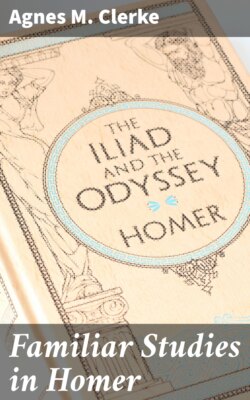Читать книгу Familiar Studies in Homer - Agnes M. Clerke - Страница 6
Оглавление48.R. Brown, Phainomena of Aratus, p. 9; Delitzsch, The Hebrew Language, p. 69.
Of the Hyades, similarly, the ‘rainy’ association seems somewhat far-fetched. They rise and set respectively about four days later than the Pleiades; so that, as prognostics of the seasons, it would be difficult to draw a permanent distinction between the two groups; yet one was traditionally held to bring fair, the other foul weather. There can be little doubt that an etymological confusion lay at the bottom of this inconsistency. ‘To rain,’ in Greek is huein; but hus (cognate with ‘sow’) means a ‘pig.’ Moreover, in old Latin, the Hyades were called Suculæ (‘little pigs’); although the misapprehension which he supposed to be betrayed by the term was rebuked by Cicero.[49] Possibly the misapprehension was the other way. It is quite likely that ‘Suculæ’ preserved the original meaning of ‘Hyades,’ and that the pluvious derivation was invented at a later time, when the conception of the seven stars in the head of the Bull as a ‘litter of pigs’ had come to appear incongruous and inelegant. It has, nevertheless, just that character of naïveté which stamps it as authentic. Witness the popular names of the sister-group—the widely-diffused ‘hen and chickens,’ Sancho Panza’s ‘las siete cabrillas,’ met and discoursed with during his famous aërial voyage on the back of Clavileño, the Sicilian ‘seven dovelets,’—all designating the Pleiades. Still more to the purpose is the Anglo-Saxon ‘boar-throng,’ which, by a haphazard identification, has been translated as Orion, but which Grimm, on better grounds, suggests may really apply to the Hyades.[50] It is scarcely credible that any other constellation can be indicated by a term so manifestly reproducing the ‘Suculæ’ of Latin and Sabine husbandmen.
49.De Naturâ Deorum, lib. ii. cap. 43.
50.Teutonic Mythology (Stallybrass), vol. ii. p. 729.
The Homeric scheme of the heavens, then (such as it is), was produced at home. No stellar lore had as yet been imported from abroad. An original community of ideas is just traceable in the names of some of the stars; that is all. The epoch of instruction by more learned neighbours was still to come. The Signs of the Zodiac were certainly unknown to Homer, yet their shining array had been marshalled from the banks of the Euphrates at least 2000 years before the commencement of the Christian era. Their introduction into Greece is attributed to Cleostratus of Tenedos, near, or shortly after, the end of the sixth century B.C. By that time, too, acquaintance had been made with the ‘Phœnician’ constellation of the Lesser Bear, and with the wanderings of the planets. Astronomical communications, in fact, began to pour into Hellas from Egypt, Babylonia, and Phœnicia about the seventh century B.C. Now, if there were any reasonable doubt that ‘blind Melesigenes’ lived at a period anterior to this, it would be removed by the consideration of what he lets fall about the heavenly bodies. For, though he might have ignored formal astronomy, he could not have remained unconscious of such striking and popular facts as the identity of Hesperus and Phosphorus, the Sidonian pilots’ direction of their course by the ‘Cynosure,’ or the mapping-out of the sun’s path among the stars by a series of luminous figures of beasts and men.
Thus the hypothesis of a late origin for the Iliad and Odyssey is negatived by the astronomical ignorance betrayed in them. It has, however, gradations; whence some hints as to the relative age of the two epics may be derived. The differences between them in this respect are, it is true, small, and they both stand approximately on the same astronomical level with the poems of Hesiod. Yet an attentive study of what they have to tell us about the stars affords some grounds for placing the Iliad, the Odyssey, and the Works and Days in a descending series as to time.
In the first place, the division of the month into three periods of ten days each is unknown in the Iliad, is barely hinted at in the Odyssey, but is brought into detailed notice in the Hesiodic calendar. Further, the ‘turning-points of the sun’ are unmentioned in the Iliad, but serve in the Odyssey, by their position on the horizon, to indicate direction; while the winter solstice figures as a well-marked epoch in the Works and Days. Hesiod, moreover, designates the dog-star (not expressly mentioned in the Odyssey) by a name of which the author of the Iliad was certainly ignorant. Besides which an additional constellation (Boötes) to those named in the Iliad appears in the Odyssey and the Works and Days; while the title ‘Hyperion,’ applied substantively to the sun in the Odyssey, is used only adjectivally in the Iliad. Finally, stellar mythology begins with Hesiod; Homer (whether the Iliadic or the Odyssean) takes the names of the stars as he finds them, without seeking to connect them with any sublunary occurrences.
To be sure, differences of place and purpose might account for some of these discrepancies, yet their cumulative effect in fixing relative epochs is considerable; and, even apart from chronology, it is something to look towards the skies with the ‘most high poet,’ and to retrace, with the aid of our own better knowledge, the simple meanings their glorious aspect held for him.
